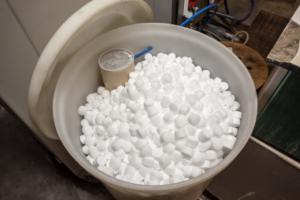
Wondering whether your water softener requires repair? Take it from a Barrington water softening company: if it’s displaying one of these four water softener symptoms, it’s time for a repair.
1. A Lack of Softener Salt
Perhaps the most common of all water softener problems is a lack of softener salt. Simply put, water softeners require softener salt in order to operate. If their salt supplies aren’t replenished on a regular basis, they will cease to function as intended.
Fortunately, this is an easy problem to combat. All you need to do is add more salt. Then, once it’s added, add some more every month or so.
Most water softeners hold around 40 pounds of salt at once. Note, however, that each softener is different and will come with its own holding capacity.
2. Broken Down Resin Beads
Another problem you might run into is broken down resin beads. Resin beads are needed to facilitate the ion-exchange process. Therefore, once they’ve broken down, they’re effectively useless.
While this problem is not a common one, it does occur from time to time. If it happens, it’s most likely going to happen toward the end of the water softener’s lifespan.
Wondering how to assess whether or not your resin beads are deteriorated? Just look into the water softener’s brine tank. If you see little chunks of resin floating at the top of the water, then the beads have deteriorated and are in need of replacement.
3. Motor Failure
One of the most severe problems a water softener can suffer is motor failure, which often occurs as a result of consistent use over the years.
When a water softener’s motor fails, there are one of two things you can do: 1. You can replace the motor with a new model, or 2. You can replace the entire water softener. If the water softener is more than 10 years old, we recommend going with the latter option. If it’s less than 10 years old, we recommend the first option.
4. Salt Bridges
The last water softener problem you should look out for is the problem of salt bridges. Salt bridges form spontaneously as a result of there being too much sodium in the brine tank. The sodium takes solid form, clinging to the interior of the brine tank and preventing water from passing through.
Salt bridges are troublesome because they either impair or eliminate the efficacy of the water softener as a whole. In other words, they prevent the water softener from producing soft water.
Fortunately, they’re fairly easy to fix. All you need is a long, narrow rod of some kind. Gently push the rod against the salt bridge until it breaks apart. Then, pick up the pieces and empty them into a bucket.
If you wish, you can perform a more intensive cleaning, draining the softener and scrubbing down its interior components. If necessary, a water softening specialist can help you with the task.
Utilize the Services of a Barrington Water Softening Company
Is your water softener experiencing problems? Are you looking to utilize the services of a Barrington water softening company? If so, we here at DuPage Water Conditioning are the company to call.
Regardless of the problem your water softener is experiencing, our specialists can fix it. We look forward to helping you.
Contact us now to get the process started!
